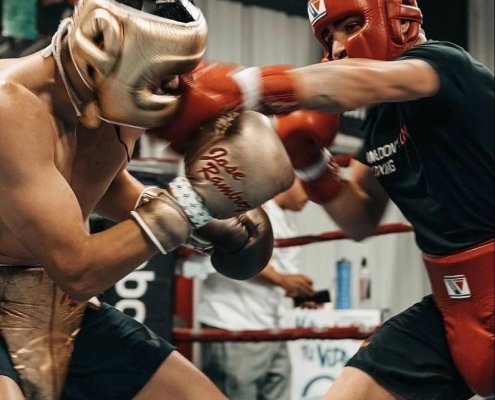Introduction
Mixed Martial Arts (MMA) stands a captivating testament to human capability. Blending power, strategic acumen, and an unparalleled intensity that seizes global attention. Amidst the multifaceted disciplines within MMA, it is the striking game that often captures the imagination, crafting powerful moments. These instances are not mere coincidences but the result of intricate planning, technical prowess, and an in-depth understanding of the mechanics of force and human resilience. This detailed exploration ventures into the world of striking in MMA, shedding light on the fundamental techniques, advanced strategies, and the artistry that elite fighters employ to achieve – the knockout.
Footwork: Choreographing Victory
Striking mastery begins with the underestimated art of footwork. This foundational skill transcends basic movement, a strategic chess match where positioning dictates the flow of combat. Elite fighters use their footwork to dictate pace and manage distance. this allows them to engage on their terms. This ballet of combat enables fighters to set traps, evade incoming threats, and position themselves for striking opportunities with precision.
Boxing: The Quintessential Art
Within the realm of MMA, the discipline of boxing serves as a cornerstone for striking. This “sweet science” merges offensive firepower with an elegant defense, offering a comprehensive toolkit for fighters. The jab, a fundamental yet potent tool, establishes range and probes the opponent’s defenses. Crosses deliver power, hooks capitalize on angles, and uppercuts exploit openings, creating a dynamic arsenal. Defensive maneuvers such as slipping and rolling transform fighters into elusive targets, making boxing not just an attack mode but a form of evasion.
Expanding the Arsenal: The Integration of Diverse Techniques
MMA striking is a rich tapestry woven from the world’s martial traditions. Kicks, from the powerful leg kicks that erode an opponent’s base to the precision of head kicks that spell instant defeat, introduce a range of tactical choices. Knees and elbows, often in the clinch, offer a brutal efficiency in close quarters, reflecting the influence of Muay Thai. This amalgamation of techniques demands not only versatility from fighters but also an acute sense of timing and spatial awareness to execute strikes with maximum effect.
Distance Management: The Conductor of the Fight
The manipulation of distance is akin to a silent conductor, guiding the tempo and rhythm of the confrontation. Mastery over this element allows a fighter to strike and evade with a grace that seems almost prescient. It’s here, in the management of inches and moments, that fights are often won or lost in the shadows, long before the final blow is struck.
 The Anatomy of a Knockout
The Anatomy of a Knockout
- Precision and Timing: The art of the knockout lies in the fusion of pinpoint accuracy with a moment’s perfect timing. Targets are not chosen at random; the chin, temple, and liver are sought with the precision of a surgeon, where a single strike can disrupt an opponent’s neurological or physiological equilibrium. This requires an intimate knowledge of human anatomy and a keen eye for reading an opponent’s movements.
- Power Generation: Behind the spectacle of power lies the kinetic chain, a principle where force is generated from the ground up, channeled through the body, and unleashed upon impact. This biomechanical harmony is the result of rigorous training and refinement, ensuring that each strike carries the full weight of the fighter’s body and skill.
- Strategic Feints and Combinations: The prelude to a knockout often involves a complex dance of feints and combinations. Like a grandmaster in chess, a fighter sets up the board, using jabs and light strikes to elicit responses, creating patterns only to break them with a sudden, decisive move. This psychological warfare sows doubt and creates openings for a finishing blow.
- Adaptive Defense to Offense: A robust defense is the springboard for effective counterattacks. By mastering the art of evasion and parrying, fighters can transition from defense to offense fluidly, exploiting brief windows of vulnerability in their opponents. This dual capability demands not only physical agility but a deep strategic foresight.
Striking Strategies: The Battle of Minds
- Divergent Paths of Styles: Striking in MMA showcases a spectrum of styles, from the aggressive berserker who seeks to overwhelm with sheer force to the calculating sniper who bides their time for the perfect shot. The interaction of these styles within the cage offers a dynamic spectacle, where strategy, skill, and spirit collide.
- The Imperative of Adaptability: The unpredictable nature of MMA demands a fighter’s ability to adapt. This means altering tactics in real-time, reading the evolving patterns of the fight, and making calculated decisions under pressure. Success in the cage is often granted to those who can anticipate their opponent’s next move and adjust faster than their adversary can react.
- Cognitive Mastery: Fight IQ: Beyond the physical, striking in MMA requires a high-level cognitive engagement. Fighters must possess a sharp fight IQ, enabling them to process information rapidly, adapt strategies, and recognize patterns in the heat of battle. This mental acuity is what separates the good from the great, turning physical exchanges into a cerebral duel.
Conclusion
The journey through the art of knockouts in MMA unravels a complex interplay of technique, strategy, and indomitable will. From the foundational importance of footwork to the devastating precision of a well-timed strike, the path to knockout glory is paved with dedication, insight, and relentless refinement. As spectators of this grand spectacle, we gain a deeper appreciation for the nuanced ballet of combat, where each knockout is not just a moment of triumph but a testament to the profound mastery over the art and science of fighting. Through this lens, MMA transcends the bounds of sport, becoming a vivid expression of human potential and spirit.


 The Anatomy of a Knockout
The Anatomy of a Knockout Combat Kinetics MMA
Combat Kinetics MMA